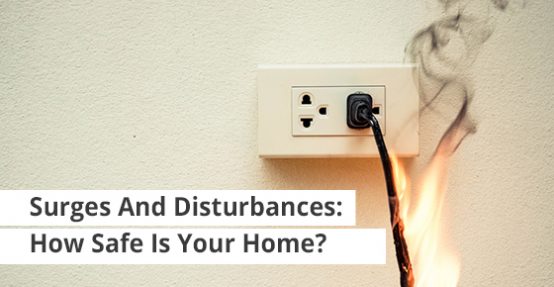
If you get your power from the national grid, then you wall outlets should have 120 volts AC power. Power companies work hard to keep the voltage of Alternating Current (AC) uniform. However, lightning, short-circuits, knocked down poles, and other accidents can cause the voltage to spike to hundreds or thousands of volts, causing what is known as a ‘power surge’.
A surge typically lasts only a fraction of a second, like a millionth of a second, because it is much faster than the ‘blink of an eye’, but the voltage spike is enough to upset or destroy your appliances.
Disturbance vs. Surge
Your electrical appliances and devices are designed to run on the normal 120 volts AC supply, with a bit of tolerance, but a major spike can easily damage them, sometimes to the extent of causing a fire.
Surges can be caused by lightning, where the surplus voltage is transmitted to the appliance via wires – power, cable, or telephone. Usually, your house is protected against the dangers of lightning by using grounded lightning rods, but these cannot prevent the surge from being transmitted through the wires.
Surges can also occur when large electrical loads are turned on or off. Large electrical appliances in your home, like heating pumps, refrigerators, and air conditioners require a lot of energy to start/stop their compressors and motors. Switching them on and off creates sudden, but very high demands of power that cause the voltage to spike or dip.
But on a fairly regular basis, the power system experiences unavoidable disturbances other than surges that can upset your electronics, but don’t usually cause any expensive or permanent damage. These disturbances can be in the form of:
These disturbances are different from surges. You can easily protect yourself from these minor voltage fluctuations by connecting your electronics via a backup battery source, also referred to as an uninterruptible power supply (UPS).
The UPS is connected directly to the wall outlet, while your electronics connect to it. In the event of a disturbance, the UPS will instantaneously switch from utility power to its own power source. So you won’t notice the voltage fluctuating, except from the UPS beep when it goes in and out of the battery mode.
How to protect against surges
Here are a few ideas to protect your electronics from power surges:
Have a functional service ground wire
This is a very important step. The service ground wire connects the electric service box in your home to the ground via a ‘ground rod’. You can ask a licensed electrician to evaluate the adequacy of your ground by measuring its resistance
Install multiple plug-in surge protectors for each electronic device in your home
All sensitive electronics in your home should be connected to surge protectors that plug-in to the wall outlet. They protect your electronics from surges by diverting the extra voltage from your equipment and sending it to your service ground.
During a severe power surge, the surge protector might get damaged instead of your equipment, so you need to keep inspecting them to ensure that your electronics are protected.
Also keep in mind that there are many types of surge protectors on the market. Only buy those with a UL rating of at least 1449, an audible alarm, and a good warranty.
Install a whole-home surge protection system at the service entrance panel
Instead of using multiple plug-in protectors for each sensitive appliance, you can invest in one surge protector that is professionally installed at the service panel (service entrance or breaker box) of your house. This single device protects all electronics in your home, though you can still use a plug-in protector with some of your sensitive equipment.
There are generally two types of service-panel protectors: those incorporated in the panel and those connected outside the panel. Some manufacturers also provide snap-in surge protectors for easy installation by a licensed electrician.
Final note
The most dangerous types of power surges are those caused by lightning, but they’re very rare. Owing to the high voltage associated with a lightning strike, most surge protectors are easily overpowered. So, you should take extra precaution during a lightning storm, and simply unplug all your valuable equipment from the wall outlet.
In addition, you should avoid sharing a single wall outlet for multiple appliances via an extension. For instance, connecting your PC and printer or AC to one plug-in can cause the appliance with huge electronic loads to put other sensitive devices when they initiate voltage disturbance while being turned on/off.
© 2023 Licensed Electrical Installation & Service – Hi-Liteelectricinc.ca
All Rights Reserved.
Leave A Comment